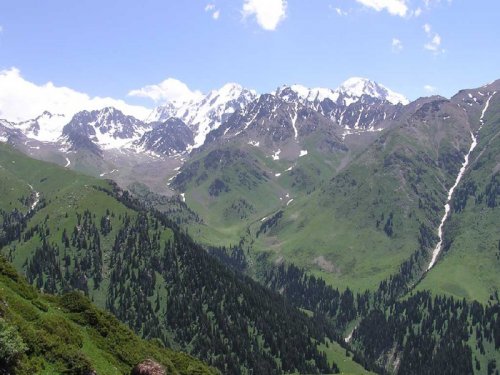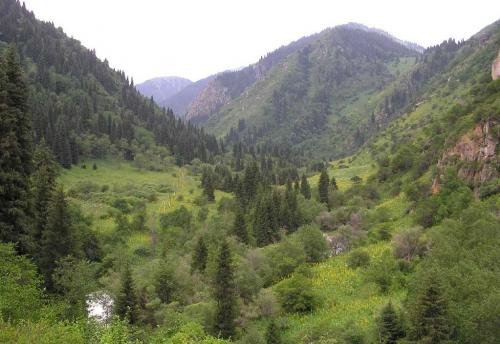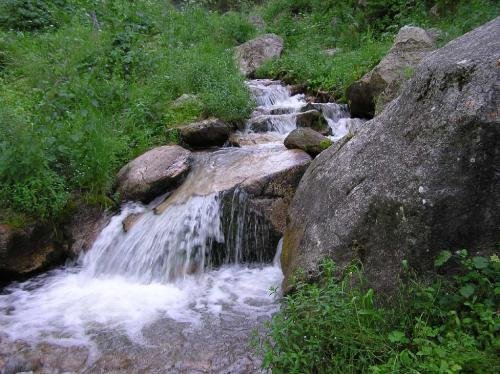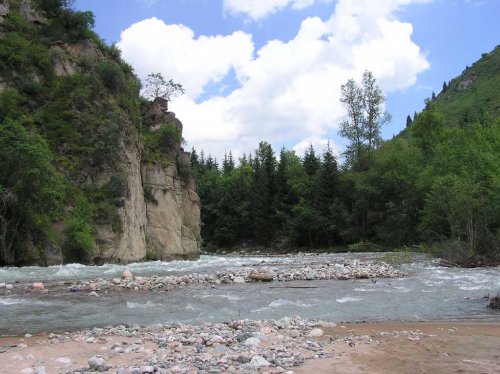Alma-Ata State Nature Reserve

The Alma-Ata Nature Reserve was organized in 1931 within the Malo-Alma-Ata forestry on the northern slope of Zailiyskiy Alatau. In 1951 the reserve was closed, and in 1961 it was restored. It is located in the central part of Zailiyskiy Alatau and on the left bank of Ili River. In terms of the area, it is one of the largest in Kazakhstan - almost 92 thousand hectares, of which 9.5 thousand hectares are forested, 14 thousand hectares are meadows and 137 hectares are reservoirs.
The territory of the protected area is located in the Talgar mountain range, the highest mountain of the reserve is also located here - Talga Peak (5,017 m). Because of the mountainous terrain, only two rivers flow here - Talgar and Issyk.
The soils in the lower part of the slopes are dark gray podzolized, degraded chernozems to varying degrees, in the higher parts the percentage of humus decreases, and the podzol content and thickness of soil horizons decrease even higher.
The climate is diverse: from hot and dry in the desert-steppe area to harsh and humid, characteristic of the Arctic tundra, in the subnival zone of Talgar.
Rivers in the Alma-Ata Nature Reserve are small, up to 10m wide and up to 1m deep. In low water, they are calm, but during the period of intense melting of snow and ice in the mountains, they turn into stormy streams, often mudflows.
There are three vegetation zones in the reserve: forest-meadow-steppe, subalpine and alpine. In the lowest part of the forest zone (1300— 1700 m above sea level), deciduous, mainly wild-fruited forests, consisting of apple trees, apricots, hawthorn in combination with aspen and willow, as well as bushes of honeysuckle, rosehip, sea buckthorn, barberry, raspberry, prevail. They are small in area, a little more than 150 hectares. Coniferous forests are located above deciduous forests, consisting exclusively of Schrenk’s spruce with an undergrowth of rowan, willow and black-fruited dogwood. At the upper border of the forest, the curtains of Siberian juniper bushes are common.
In the Subalnian belt, spruce grows in separate groves, climbing along the decays and saddles with tongues to the Alpine belt. The northern slopes are mainly covered with forest, on the southern, in the zone of the lower forest belt, mainly steppe vegetation grows. Bremer’s timothy, Geneshin’s fescue, wormwood, and hairy grasshopper are common here. The western and eastern slopes are, as a rule, areas adjacent to river valleys, therefore, meadows are more common here, the vegetation of which consists of bluegrass, hogweed, granaries, bluebells, astragalus, etc. Forget-me-nots, geraniums, lady’s-mantle, knotweeds, chickweeds and gentians are widespread in subalpine meadows. Even higher, on alpine meadows, there are grass-forb low-growing groups adapted to the harsh climate of the highlands.
The Alma-Ata Nature Reserve is a complex relief and mosaic of rocks, which greatly affect the animal world. There are 64 species of mammals and about 200 species of birds. Persian gazelle and argali live in the desert-steppe part, in the Kalkany stow, where several treeless hills are cut by a network of dry washouts. In some places there are quite good steppe pastures, which allows animals to exist normally. However, in winter pastures do not provide them with enough food and the animals are forced to migrate outside the reserve.
In the mountainous part, roe deer, maral, wild boar and Siberian ibex are common. The first three species are few, mainly due to the deep snow, as well as due to the lack of winter food. Siberian capricorns are much more numerous. They live in the subalpine and alpine zones, near the upper border of the forest, in the zone of open rocks and rocky placers, but quite often descend into the forest zone. In winter, during the period of deep snow, the ungulates of the mountainous region sometimes migrate to the southern slopes of the mountains, where either there is no snow at all, or it quickly melts out. As a rule, such sites are located outside the reserve, in a protected area.
The snow leopard is rare in the reserve and is not found every year. Traces of its vital activity are noted only in high—altitude areas, in the habitats of Asiatic ibex - the main “victim” of this large cat. Lynx is common, but its numbers are small. There are also a few white-footed brown bears that live in the spruce forests of the middle mountains, but during the ripening and falling of wild fruits they come down to deciduous forests, where they feed on apples and apricots. Wolves stay in the reserve mainly in the summer, in winter they often migrate after herds of domestic animals grazing on mountain pastures near the borders of the reserve. The fox lives in treeless high-altitude areas. In winter, however, it comes lower, into the forest zone.
They are quite fully represented in the Alma-Ata Kunya Reserve. There are badgers, otter, stone marten, ermine, sable, imported to Zailiyskiy Alatau in the early 60s, runs in. The most common marten is the stone marten. It lives in the entire strip of the forest zone, sometimes even coming down to the foothills. Depending on the season of the year, it moves from the upper border of the forest (during the snowless period), where it feeds on rodents, to the deciduous forest (in winter), in which it hunts fruit carrion, berries and random small animals and birds.
There are a lot of red pipits in the reserve, living in the highlands, in the zone of alpine and subalpine meadows, rocky placers. On the southern slopes of some spurs, small colonies of gray marmots can be found; Altai squirrels (Sciurus vulgaris exalbidus), acclimatized in the forests of Zailiyskiy Alatau in the early 60s, also run here. There are numerous fat dormouse, Tyanypan bush mouse, gray hamster, mole vole, mountain silver, forest and common voles, forest mouse, Tyanypan and small common shrew, whiskered bat, common Bat, common long-eared Bat and common serotine. Sometimes a tolai hare runs along the Issyk Valley.
In spruce forests, there are common crossbills, nutcracker, a lot of small feathered animals: tree pipits, mouse hares, Chinese willow tit, Tyanypan kinglets, blue-headed redstarts, black-throated accentors. The booted owlet, three-toed woodpecker, hawk owl, long-eared owl, carrion crow and owl are common. In the river valleys, riverine areas, there are many brown and white-bellied dippers, Blyth’s reed warblers, whitethroats and bluethroats. Blue whistling thrush and sulphur leaf warbler are common here. In the Alpine and subalpine belts, wallcreeper, red-mantled grosbeak, painted tits, rednecked nightingale, black redstart, rufous-backed redstart, red-mantled rosefinch, rock pipit, Altai jackdaw, chough, Altai finch, Giildenstadt’s redstart, solitary snipe, etc. are common. The bearded vulture, snow cock, partridge, black grouse and even pheasant live in the reserve. Of the reptiles, there are the Alai snake-eyed skinks, mocassin and lake frog.
The direction of scientific research of the Alma-Ata Nature Reserve is a comprehensive study of the ecology of valuable plants and animals, identification of factors affecting the normal functioning of the biogeocenoses protected in the reserve.
The territory of the protected area is located in the Talgar mountain range, the highest mountain of the reserve is also located here - Talga Peak (5,017 m). Because of the mountainous terrain, only two rivers flow here - Talgar and Issyk.
The soils in the lower part of the slopes are dark gray podzolized, degraded chernozems to varying degrees, in the higher parts the percentage of humus decreases, and the podzol content and thickness of soil horizons decrease even higher.
The climate is diverse: from hot and dry in the desert-steppe area to harsh and humid, characteristic of the Arctic tundra, in the subnival zone of Talgar.
Rivers in the Alma-Ata Nature Reserve are small, up to 10m wide and up to 1m deep. In low water, they are calm, but during the period of intense melting of snow and ice in the mountains, they turn into stormy streams, often mudflows.
There are three vegetation zones in the reserve: forest-meadow-steppe, subalpine and alpine. In the lowest part of the forest zone (1300— 1700 m above sea level), deciduous, mainly wild-fruited forests, consisting of apple trees, apricots, hawthorn in combination with aspen and willow, as well as bushes of honeysuckle, rosehip, sea buckthorn, barberry, raspberry, prevail. They are small in area, a little more than 150 hectares. Coniferous forests are located above deciduous forests, consisting exclusively of Schrenk’s spruce with an undergrowth of rowan, willow and black-fruited dogwood. At the upper border of the forest, the curtains of Siberian juniper bushes are common.
In the Subalnian belt, spruce grows in separate groves, climbing along the decays and saddles with tongues to the Alpine belt. The northern slopes are mainly covered with forest, on the southern, in the zone of the lower forest belt, mainly steppe vegetation grows. Bremer’s timothy, Geneshin’s fescue, wormwood, and hairy grasshopper are common here. The western and eastern slopes are, as a rule, areas adjacent to river valleys, therefore, meadows are more common here, the vegetation of which consists of bluegrass, hogweed, granaries, bluebells, astragalus, etc. Forget-me-nots, geraniums, lady’s-mantle, knotweeds, chickweeds and gentians are widespread in subalpine meadows. Even higher, on alpine meadows, there are grass-forb low-growing groups adapted to the harsh climate of the highlands.
The Alma-Ata Nature Reserve is a complex relief and mosaic of rocks, which greatly affect the animal world. There are 64 species of mammals and about 200 species of birds. Persian gazelle and argali live in the desert-steppe part, in the Kalkany stow, where several treeless hills are cut by a network of dry washouts. In some places there are quite good steppe pastures, which allows animals to exist normally. However, in winter pastures do not provide them with enough food and the animals are forced to migrate outside the reserve.
In the mountainous part, roe deer, maral, wild boar and Siberian ibex are common. The first three species are few, mainly due to the deep snow, as well as due to the lack of winter food. Siberian capricorns are much more numerous. They live in the subalpine and alpine zones, near the upper border of the forest, in the zone of open rocks and rocky placers, but quite often descend into the forest zone. In winter, during the period of deep snow, the ungulates of the mountainous region sometimes migrate to the southern slopes of the mountains, where either there is no snow at all, or it quickly melts out. As a rule, such sites are located outside the reserve, in a protected area.
The snow leopard is rare in the reserve and is not found every year. Traces of its vital activity are noted only in high—altitude areas, in the habitats of Asiatic ibex - the main “victim” of this large cat. Lynx is common, but its numbers are small. There are also a few white-footed brown bears that live in the spruce forests of the middle mountains, but during the ripening and falling of wild fruits they come down to deciduous forests, where they feed on apples and apricots. Wolves stay in the reserve mainly in the summer, in winter they often migrate after herds of domestic animals grazing on mountain pastures near the borders of the reserve. The fox lives in treeless high-altitude areas. In winter, however, it comes lower, into the forest zone.
They are quite fully represented in the Alma-Ata Kunya Reserve. There are badgers, otter, stone marten, ermine, sable, imported to Zailiyskiy Alatau in the early 60s, runs in. The most common marten is the stone marten. It lives in the entire strip of the forest zone, sometimes even coming down to the foothills. Depending on the season of the year, it moves from the upper border of the forest (during the snowless period), where it feeds on rodents, to the deciduous forest (in winter), in which it hunts fruit carrion, berries and random small animals and birds.
There are a lot of red pipits in the reserve, living in the highlands, in the zone of alpine and subalpine meadows, rocky placers. On the southern slopes of some spurs, small colonies of gray marmots can be found; Altai squirrels (Sciurus vulgaris exalbidus), acclimatized in the forests of Zailiyskiy Alatau in the early 60s, also run here. There are numerous fat dormouse, Tyanypan bush mouse, gray hamster, mole vole, mountain silver, forest and common voles, forest mouse, Tyanypan and small common shrew, whiskered bat, common Bat, common long-eared Bat and common serotine. Sometimes a tolai hare runs along the Issyk Valley.
In spruce forests, there are common crossbills, nutcracker, a lot of small feathered animals: tree pipits, mouse hares, Chinese willow tit, Tyanypan kinglets, blue-headed redstarts, black-throated accentors. The booted owlet, three-toed woodpecker, hawk owl, long-eared owl, carrion crow and owl are common. In the river valleys, riverine areas, there are many brown and white-bellied dippers, Blyth’s reed warblers, whitethroats and bluethroats. Blue whistling thrush and sulphur leaf warbler are common here. In the Alpine and subalpine belts, wallcreeper, red-mantled grosbeak, painted tits, rednecked nightingale, black redstart, rufous-backed redstart, red-mantled rosefinch, rock pipit, Altai jackdaw, chough, Altai finch, Giildenstadt’s redstart, solitary snipe, etc. are common. The bearded vulture, snow cock, partridge, black grouse and even pheasant live in the reserve. Of the reptiles, there are the Alai snake-eyed skinks, mocassin and lake frog.
The direction of scientific research of the Alma-Ata Nature Reserve is a comprehensive study of the ecology of valuable plants and animals, identification of factors affecting the normal functioning of the biogeocenoses protected in the reserve.
Photo gallery
Contacts
General questions
Expedition, events
Interaction with Media
Legal information
ACCESSION QUESTIONARY
Individual
Status (on the procedure of accession to members and membership in the RPA in PDF format)
Legal entity
Status (on the procedure of accession to members and membership in the RPA in PDF format)

Спасибо!
Ваша заявка успешно отправлена
Мы свяжемся с вами в ближайшее время
Submit a work to the “My Kazakhstan” contest

Спасибо!
Ваше фото успешно отправлено
Ожидайте выбора победителей!

Спасибо!
Ваш заказ успешно отправлен
Мы свяжемся с вами в ближайшее время




